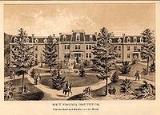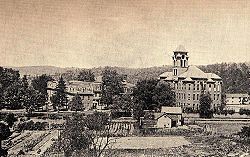
West Virginia Schools for the Deaf and Blind
Encyclopedia
The West Virginia
Schools for the Deaf and Blind were established by an Act of the Legislature on March 3, 1870. The School for the Deaf and the School for the Blind offer comprehensive educational programs for hearing impaired and visually impaired students respectively. There is also a unit for deafblind and multihandicapped children. Students are eligible to enroll at the age of three. They must also be residents of the state of West Virginia
and exhibit a hearing or visual loss sufficient enough to prevent normal progress in the usual public school setting. The West Virginia Schools for the Deaf and Blind are located on a campus in Romney
in West Virginia
's Eastern Panhandle. Locally, the schools are referred to simply as The D&B School.
Both the School for the Deaf and the School for the Blind are supervised by the West Virginia Board of Education, supported by the state of West Virginia, and fully accredited by the North Central Association for Colleges and Schools at the elementary and secondary levels.
 The idea to establish a school in West Virginia for the deaf and blind began in 1869 or early 1870. Professor H. H. Johnson of Franklin
The idea to establish a school in West Virginia for the deaf and blind began in 1869 or early 1870. Professor H. H. Johnson of Franklin
, himself blind, was instrumental in bringing a school for the deaf and blind to West Virginia. During his youth, Johnson had attended the Virginia School for the Deaf and the Blind in Staunton
, Virginia. Shortly after West Virginia's statehood, Johnson recognized the need for such a school in the state and he began canvassing the state, gathering support for his project. Several towns including Romney, Clarksburg
, and Parkersburg
all lobbied to have the school located there, but Romney was selected following an offer consisting of the buildings and grounds of the Romney Literary Society's Romney Classical Institute. The Romney Classical Institute had lain dormant since the American Civil War
when its libraries' volumes were destroyed and its campus was left beyond repair.
On March 3, 1870, H. H. Johnson's dreams became a reality when the West Virginia Legislature
approved a measure calling for the creation of the West Virginia Institution for the Deaf and Dumb and the Blind. The school opened on September 29, 1870 with thirty students, twenty-five deaf and five blind students. Through the years, additional buildings and grounds have been added to accommodate increasing enrollment. Currently, the main campus consists of sixteen major buildings, containing approximately 302000 square feet (28,056.7 m²), situated on seventy-nine acres of land.
On May 17, 1916, Helen Keller
visited the West Virginia Schools for the Deaf and Blind.
West Virginia
West Virginia is a state in the Appalachian and Southeastern regions of the United States, bordered by Virginia to the southeast, Kentucky to the southwest, Ohio to the northwest, Pennsylvania to the northeast and Maryland to the east...
Schools for the Deaf and Blind were established by an Act of the Legislature on March 3, 1870. The School for the Deaf and the School for the Blind offer comprehensive educational programs for hearing impaired and visually impaired students respectively. There is also a unit for deafblind and multihandicapped children. Students are eligible to enroll at the age of three. They must also be residents of the state of West Virginia
West Virginia
West Virginia is a state in the Appalachian and Southeastern regions of the United States, bordered by Virginia to the southeast, Kentucky to the southwest, Ohio to the northwest, Pennsylvania to the northeast and Maryland to the east...
and exhibit a hearing or visual loss sufficient enough to prevent normal progress in the usual public school setting. The West Virginia Schools for the Deaf and Blind are located on a campus in Romney
Romney, West Virginia
Romney is a city in and the county seat of Hampshire County, West Virginia, United States. The population was 1,940 at the 2000 census, while the area covered by the city's ZIP code had a population of 5,873. It is a city with a very historic background dating back to the 18th century...
in West Virginia
West Virginia
West Virginia is a state in the Appalachian and Southeastern regions of the United States, bordered by Virginia to the southeast, Kentucky to the southwest, Ohio to the northwest, Pennsylvania to the northeast and Maryland to the east...
's Eastern Panhandle. Locally, the schools are referred to simply as The D&B School.
Both the School for the Deaf and the School for the Blind are supervised by the West Virginia Board of Education, supported by the state of West Virginia, and fully accredited by the North Central Association for Colleges and Schools at the elementary and secondary levels.
History

Franklin, West Virginia
Franklin is a town in Pendleton County, West Virginia, United States. The population was 797 at the 2000 census. It is the county seat of Pendleton County...
, himself blind, was instrumental in bringing a school for the deaf and blind to West Virginia. During his youth, Johnson had attended the Virginia School for the Deaf and the Blind in Staunton
Staunton, Virginia
Staunton is an independent city within the confines of Augusta County in the commonwealth of Virginia. The population was 23,746 as of 2010. It is the county seat of Augusta County....
, Virginia. Shortly after West Virginia's statehood, Johnson recognized the need for such a school in the state and he began canvassing the state, gathering support for his project. Several towns including Romney, Clarksburg
Clarksburg, West Virginia
Clarksburg is a city in and the county seat of Harrison County, West Virginia, United States, in the north-central region of the state. It is the principal city of the Clarksburg, WV Micropolitan Statistical Area...
, and Parkersburg
Parkersburg, West Virginia
As of the census of 2000, there were 33,099 people, 14,467 households, and 8,767 families residing in the city. In 2006 the U.S. Census Bureau estimated that Parkersburg's population had decreased 4.4% to 31,755. The population density was 2,800.5 people per square mile . There were 16,100 housing...
all lobbied to have the school located there, but Romney was selected following an offer consisting of the buildings and grounds of the Romney Literary Society's Romney Classical Institute. The Romney Classical Institute had lain dormant since the American Civil War
American Civil War
The American Civil War was a civil war fought in the United States of America. In response to the election of Abraham Lincoln as President of the United States, 11 southern slave states declared their secession from the United States and formed the Confederate States of America ; the other 25...
when its libraries' volumes were destroyed and its campus was left beyond repair.
On March 3, 1870, H. H. Johnson's dreams became a reality when the West Virginia Legislature
West Virginia Legislature
The West Virginia Legislature is the state legislature of the U.S. state of West Virginia. A bicameral legislative body, the Legislature is split between the upper Senate and the lower House of Delegates. It was established under Article VI of the West Virginia Constitution following the state's...
approved a measure calling for the creation of the West Virginia Institution for the Deaf and Dumb and the Blind. The school opened on September 29, 1870 with thirty students, twenty-five deaf and five blind students. Through the years, additional buildings and grounds have been added to accommodate increasing enrollment. Currently, the main campus consists of sixteen major buildings, containing approximately 302000 square feet (28,056.7 m²), situated on seventy-nine acres of land.
On May 17, 1916, Helen Keller
Helen Keller
Helen Adams Keller was an American author, political activist, and lecturer. She was the first deafblind person to earn a Bachelor of Arts degree....
visited the West Virginia Schools for the Deaf and Blind.

